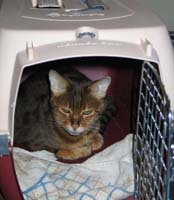Cat Carrier Trauma! Trips to the Veterinarian
Many cats and their favorite people view cat carriers with trepidation. As soon as the carrier looms into view the cats hastily retreat as far away as possible, usually securing themselves in hard to reach places. A typical scenario is one where stressed cat parents risk injury while chasing, cornering and then depositing their cat kicking and screaming into the carrier. Because of traumatic carrier experiences, many cats do not benefit from being examined by their veterinarians on a regular basis.
It doesn’t have to be this way. Instead of a place to avoid, the carrier can become fun for your cat—a place where the cat enjoys playing, napping and eating favorite treats.
Plan ahead!
Start changing your cat’s fearful feelings about her carrier several weeks before the visit to her veterinarian. The best carrier for the job is a hard carrier because it can be easily taken apart both at home and at the vet clinic.
Typically carriers are stashed out of the way in between the dreaded visits to the vet. This isn’t the best tactic since it doesn’t take long for the cat to figure out that when the carrier appears something bad is about to happen. A less stressful approach is to permanently place the carrier in an area the cat hangs out in. That way the carrier becomes a fixture in the environment and with encouragement, a place to sleep, play and eat treats.
Influence your cat to change her fearful association of the carrier through activities she enjoys. If she loves playing, drag her favorite toys over the carrier or toss them in for her to chase. If she adores treats, place them in the carrier.
Scent can also help her view the carrier as a non-threatening place to hang out. Pet her with a soft towel and then place the towel in the carrier. Placing a towel or article of clothing that is saturated with the cat’s favorite person’s scent will also help change her perception of the carrier.
Whenever the cat chooses to go into the carrier on her own she should be reinforced with something that she loves. If she loves treats, then give her a favorite treat. If she enjoys a little loving, then pet and stroke her when she is relaxing in the carrier.
Cats are individuals—some change their feelings about cat carriers in about a week. Others require a few weeks or a couple of months until they do not have a fearful association with their carriers. Clicker training also helps speed up the process. There is a chapter in my book Naughty No More! that focuses on using clicker training along with other force-free methods to help cats improve their relationship with their carriers and veterinarians.




